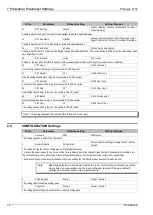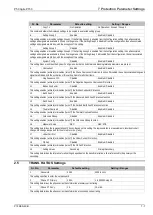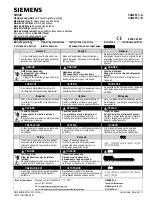
P50 Agile P153
6 Protection Functions
P153/EN M/B
6-9
The Strt I2>(n) signal is fed into a timer to produce the Trip I2>(n) signal.
The Negative Sequence overcurrent trip signal can be blocked by:
•
The Second Harmonic blocking function which is for all three phases. The blocking is activated
by setting the
I2>
(n)
2H Blocking
cell to ‘Enabled’, where (n) is the number of the stage.
•
User defined blocking logic using ‘IO Mask’ functionality.
2.4
Earth Fault Protection
Earth faults are simply overcurrent faults where the fault current flows to earth (as opposed to between
phases). They are the most common type of fault. There are a few different kinds of earth fault, but the
most common is the single phase-to-earth fault. Consequently, this is the first and foremost type of
fault that protection devices must cover.
Typical settings for earth fault IEDs are around 30-40% of the full load current. If greater sensitivity is
required, then Sensitive Earth Fault should be used.
Earth faults can be measured directly from the system by means of:
•
A separate CT located in a power system earth connection
•
A separate Core Balance CT (CBCT)
•
A residual connection of the three line CTs, whereby the Earth faults can be derived
mathematically by summing the three measured phase currents.
Depending on the device model, it will provide one or more of the above means for Earth fault
protection.
2.4.1
Earth Fault Protection Elements
Earth fault protection is implemented in the columns
EARTH FAULT 1
and
EARTH FAULT 2
of the
relevant settings group.
Each column contains an identical set of elements, whereby the
EARTH FAULT 1
(IN1) column is
used for earth fault current that is measured directly from the system, whilst the
EARTH FAULT 2
(IN2) column contains cells, which operate from a residual current quantity that is derived internally
from the summation of the three-phase currents.
The product provides three stages of Earth Fault protection with independent time delay
characteristics, for each
EARTH FAULT
column.
Stages 1, 2 and 3 provide a choice of operate and reset characteristics, where you can select
between:
•
A range of standard IDMT (Inverse Definite Minimum Time) curves
•
DT (Definite Time)
For the IN1 column, this is achieved using the cells:
•
IN1>
(n)
Function
for the overcurrent operate characteristics
•
IN1>
(n)
Reset Char
for the overcurrent reset characteristic
For the IN2 column, this is achieved using the cells:
•
IN2>
(n)
Function
for the overcurrent operate characteristics
•
IN2>
(n)
Reset Char
for the overcurrent reset characteristic
where (n) is the number of the stage.
Stages 1, 2 and 3 provide a Timer Hold facility. This is configured using the cells
IN1>
(n)
tRESET
for
Earth Fault 1 and
IN2>
(n)
tRESET
for Earth Fault 2.
Summary of Contents for Agile P50 Series
Page 3: ...P50 Agile P153 1 Introduction P153 EN M B 1 1 INTRODUCTION CHAPTER 1...
Page 4: ...1 Introduction P50 Agile P153 1 2 P153 EN M B...
Page 10: ...1 Introduction P50 Agile P153 1 8 P153 EN M B...
Page 11: ...P50 Agile P153 2 Safety Information P153 EN M A 2 1 SAFETY INFORMATION CHAPTER 2...
Page 22: ...Chapter 2 Safety Information P50 Agile P153 2 12 P153 EN M A...
Page 23: ...P50 Agile P153 3 Hardware Design P153 EN M B 3 1 HARDWARE DESIGN CHAPTER 3...
Page 24: ...3 Hardware Design P50 Agile P153 3 2 P153 EN M B...
Page 32: ...3 Hardware Design P50 Agile P153 3 10 P153 EN M B...
Page 33: ...P50 Agile P153 4 Front Panel P153 EN M B 4 1 FRONT PANEL CHAPTER 4...
Page 34: ...4 Front Panel P50 Agile P153 4 2 P153 EN M B...
Page 39: ...P50 Agile P153 5 Configuration P153 EN M B 5 1 CONFIGURATION CHAPTER 5...
Page 40: ...P50 Agile P153 5 Configuration P153 EN M B 5 2...
Page 150: ...P50 Agile P153 5 Configuration P153 EN M B 5 112...
Page 151: ...P50 Agile P153 6 Protection Functions P153 EN M B 6 1 PROTECTION FUNCTIONS CHAPTER 6...
Page 152: ...6 Protection Functions P50 Agile P153 6 2 P153 EN M B...
Page 168: ...7 Protection Parameter Settings P50 Agile P153 7 2 P153 EN M B...
Page 189: ...P50 Agile P153 8 Monitoring Control P153 EN M B 8 1 MONITORING CONTROL CHAPTER 8...
Page 190: ...8 Monitoring Control P50 Agile P153 8 2 P153 EN M B...
Page 207: ...P50 Agile P153 9 SCADA Communications P153 EN M B 9 1 SCADA COMMUNICATIONS CHAPTER 9...
Page 208: ...12 SCADA Communications P50 Agile P153 9 2 P153 EN M B...
Page 220: ...12 SCADA Communications P50 Agile P153 9 14 P153 EN M B...
Page 221: ...P50 Agile P153 10 Installation P153 EN M B 10 1 INSTALLATION CHAPTER 10...
Page 222: ...10 Installation P50 Agile P153 10 2 P153 EN M B...
Page 234: ...13 Commissioning Instructions P50 Agile P153 13 2 P153 EN M B...
Page 242: ...12 Maintenance and Troubleshooting P50 Agile P153 12 2 P153 EN M B...
Page 250: ...12 Maintenance and Troubleshooting P50 Agile P153 12 10 P153 EN M B...
Page 252: ...13 Technical Specifications P50 Agile P153 13 2 P153 EN M B...
Page 263: ...P50 Agile P153 14 Wiring Diagrams P153 EN M B 14 1 WIRING DIAGRAMS CHAPTER 14...
Page 264: ...14 Wiring Diagrams P50 Agile P153 14 2 P153 EN M B...
Page 267: ......
















































